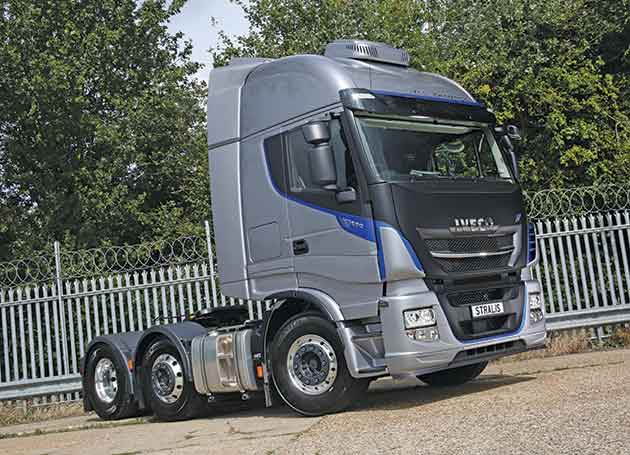
This is the last Iveco Stralis to be put under the spotlight, as it’ll be replaced by the S-Way next year. The outgoing model has had a good run, with the XP a culmination of the manufacturer’s fuel saving technology. Kevin Swallow spent one last day in the flagship 570 with a standard rear axle ratio and more oomph.
EARLIER this year, Iveco unveiled its new S-Way long haul tractor unit complete with its all-new cab. After the engine and driveline updates in 2016, this was the final act. Unlike many of its competitors, when the Italians said it was a ‘new cab’ they actually meant it. The right hand drive S-Way arrives in the Spring.
In the meantime it’s a long goodbye to Stralis that was launched way back in 2002 as ‘the most technologically advanced vehicle available’.
While Stralis stuttered through its infancy with electrical issues before eventually catching up with improved build quality and better reliability, its real success has been the engines and the Euro emission strategy.
Plumping for selective catalytic reduction (SCR) through Euro 4 and 5, it was retained for Euro 6 and deserves credit because it was the only manufacturer to go down this route exclusively.
Since then others, most notably Scania, have realised the folly of relying on internal combustion to eliminate harmful pollutants, which is a particularly difficult task during low heat.
A tweak to the engines three years ago resulted in Cursor 13 getting a 10hp hike in power to 510 and 570hp. And for this, Iveco shrewdly rowed back on its SCR only policy for Euro 6 by introducing 8% exhaust gas recirculation (EGR) calling it ‘Smart EGR’; a tactic employed by Volvo Trucks.
It was added as part of a new XP (extra performance) long haul fuel saving product line. Smart EGR is a ‘fuel economy enabler’ that burns NOx inside the engine when the temperature is up. Tinkering with the diesel injection timing allows an earlier start of injection into the piston chamber during the combustion process.
There is some additional NOx but not enough to require a ramp up in AdBlue dosage to deal with it, which leaves the existing SCR system to deal with pretty much the same volume of NOx as before.
It avoids additional costs associated with building in required EGR components to deal with NOx. The engine remains regeneration free with no impact on the radiator size or extra maintenance. The result is a simple, low cost system.
Manufacturer claims that it improved fuel efficiency by 11% was bold. Anecdotally, operators speaking to Transport News suggest improvements are more in the single figures. Still, better than a poke in the eye.
Two years ago (TN, December 2017) the Stralis XP460 with the 2.47 rear axle ratio was put through its paces. This time Iveco has put its badged 570 up for test.
Called Cursor 13, the engine is a 12.9 litre six cylinder Euro 6 Step D with electronic variable geometry turbocharger (eVGT) and electronic common rail. It delivers a true rating of 563hp at 1,900rpm, and generates 2,500Nm torque from 1,000rpm.
Transmission is the ZF Traxon 12 speed direct top that replaced AS-Tronic. It is fitted with the standard issue 2.64 rear axle ratio. Options include the longer 2.47 rear axle ratio provided by Meritor and three shorter ones; 2.85, 3.08 and 3.64.
At 56mph the engine works at 1,278rpm, which is 7% more revolutions compared to the 2.47 rear axle ratio.
The truck is also fitted with Hi-Cruise. This is Iveco’s version of predictive cruise control that uses GPS mapping to instigate eco roll and gear changes. Top speed can be limited to 53mph and torque requirements are adjusted in accordance with the weight of the truck.
At the launch Iveco pointed out that saving money on fuel and ownership will come at a price; XP costs 9% more than a standard Stralis with a two year return on investment.
From Carlisle north towards Glasgow on the M74, the truck ran in Hi-Cruise at 53mph (to allow other truckers to pass comfortably). The engine works effortlessly at 1,100 to 1,200rpm.
While rev count is a tad high nowadays it does allow the engine to dig in rather than change down the box for any of the shallower ascents in the run up to Beattock.
On the first steep climb after J15 the transmission dropped a gear, then came off the gas as it approached the first peak. As it gathered momentum into the vale Hi-Cruise applied the engine brake and then set about the second part of the climb by dropping another gear to 10th.
It pretty much replicated the 460 in Hi-Cruise with the 2.47 rear axle. The difference was recovery; the 570 was back up through the box and back to the governed road speed much quicker.
Otherwise the 570s use of Hi-Cruise is the same as the 460; subtle, gradual and occasionally kicking in when natural instinct tells you to put your foot down.
The workspace for the driver is the XP Active Space Evo high roof cab. Internal height is 2.0m standing between the seats, the engine cover is 22cm and the cab floor height is 1.40m.
In context with other flagship motors built by Iveco’s competitors; it is the lowest internal height, the highest engine tunnel cover and lowest cab floor height. Of course, all that changes when S-Way arrives.
The XP Active Space Evo high roof cab is a twin bunk cabin, with the lower mattress 800mm wide and more than 2,000mm long, it uses wooden slats and a mattress with a reclining backrest to create a ‘chaise longue’.
There are two external lockers, and two lockers that can be accessed internally from under the bunk. In front of the bunk is additional storage for bottles, a fridge-freezer and a coolbox, and there is additional storage above the windscreen. Total storage is more than 50 litres; there is space at the end of the bunk to hang clothing and wiring to fit a TV on the nearside wall.
Iveco’s focus for XP is soft touch with non-reflective materials. To combat summer/winter the driver’s seat has a cool/heat option to go with an array of air operated adjustments.
It is worth noting that Stralis is just 17 years old, and the cab hasn’t kept pace with its competitors, some of whom are more than twice its age.
As a last throw of the dice, Iveco has made a decent fist of it when creating XP. It is a comfortable place to occupy for up to six days a week and I think it acts as a decent intermediate ahead of the S-Way.
Where it has scored well is the engine and driveline. Iveco rejected EGR for SCR and operators reaped the benefit with better fuel consumption without the regeneration issues.
As for specification, I’ve long argued that operators prefer a shorter rear axle drive ratio to cope with the undulating terrains to help keep the average speed higher.
Putting together a 2.64 rear axle ratio and 570hp copes with the hills without haemorrhaging gears and momentum. The quicker route time (the 570 took 13 minutes less than the 460 to complete the same journey) justifies that assertion.
This specification is really the one hauliers should go for, because it delivers the ability to climb as well as working efficiently just about everywhere else. Most of the time it is a big engine working lazily.
Although XP has only enjoyed a four year production run it has won over hauliers with its style and fuel saving technologies. Enough perhaps to generate more sales before it becomes a part of road haulage history.




